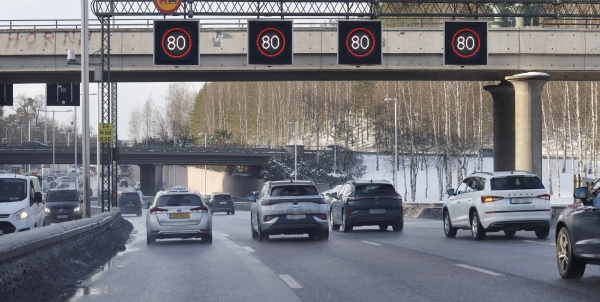Good compliance, less environmental impact and better road safety. The same journey times on average, but fewer very long queues. A variable speed limit trial has shown a number of benefits – and actually no disadvantages. “This method should be used more,” says the researcher responsible for the project.

Variable speed limits have been used in Sweden for a long time, but to improve safety when queues build up and speeds must be reduced quickly. In a recently concluded project, researchers at VTI and Linköping University investigated how variable speed limits can be used in normal, but dense, traffic and how they affect traffic flow, the environment and safety.
Traffic on a stretch of the E4 south of Södertälje was studied during the period October 2021 to May 2022. When the traffic became sufficiently dense (more than 16 vehicles per kilometre per lane) the speed limit on the electronic signs was reduced from 100 to 80 kilometres per hour. The reduction had a number of positive effects, not least for compliance.
Average speed fell by 4–12 kilometres per hour to an average of 80 kilometres per hour, i.e. the posted speed limit.
“Previous studies have shown that compliance is often quite poor, so this was rather a surprise. But in this case, the dense traffic probably meant that people realised why the speed limit was being lowered. It was probably perceived as reasonable and motivated people to drive more slowly,” says project manager Ellen Grumert, who also believes that the red ring around the speed marking helped with compliance.
Also, speeds in the outside lane fell the most, which caused speeds to even out in all three lanes. This caused less changing from lane to lane, which in turn reduced the risk of accidents – another positive result of the study. It has long been known that lower speeds also reduce emissions and environmental impact, which is yet another positive consequence.
As regards mobility and traffic flow, average journey times are the same, with or without variable speeds. On average, queues became a little longer, but there were fewer really long queues. Journey times were generally more similar, with fewer very long or short journey times.
“This should be a positive thing for motorists, because really long journey times are perceived as especially annoying. It should also be a good thing to be able to say more exactly how long a journey is going to take,” says Ellen Grumert, who believes that the perceived mobility has also improved.
All in all, the researchers believe that variable speed limits are a cost-effective way to improve the traffic situation on motorways, where bottlenecks are common. In particular, this means that a system of variable speed limits is already in place and in use before queues build up. So signs and other equipment have to be in place, which naturally represents an investment. This measure also gives the opportunity to make very localised changes in speed limits where greater problems have been observed.
The researchers in the project have also developed a new method of evaluating before and after studies of changed speed limits.
“The results show that the method used to analyse before and after studies can be very important for the outcome. Within the project, we have developed a data-driven method that reduces manual work on data and at the same time provides a good basis for making fair comparisons of the system being evaluated,” says David Gundlegård, associate professor at Linköping University.
Both reports were funded by the Swedish Transport Administration via the competence centre CTR, Centre for Traffic Research.
Ellen Grumert – Research Director, VTI
Text: Mikael Sönne – Translation: CBG
The report (in Swedish): Utvärdering och styrning med variabla hastighetsgränser med fokus på framkomlighet: en fallstudie på E4 vid Södertälje






Follow us: